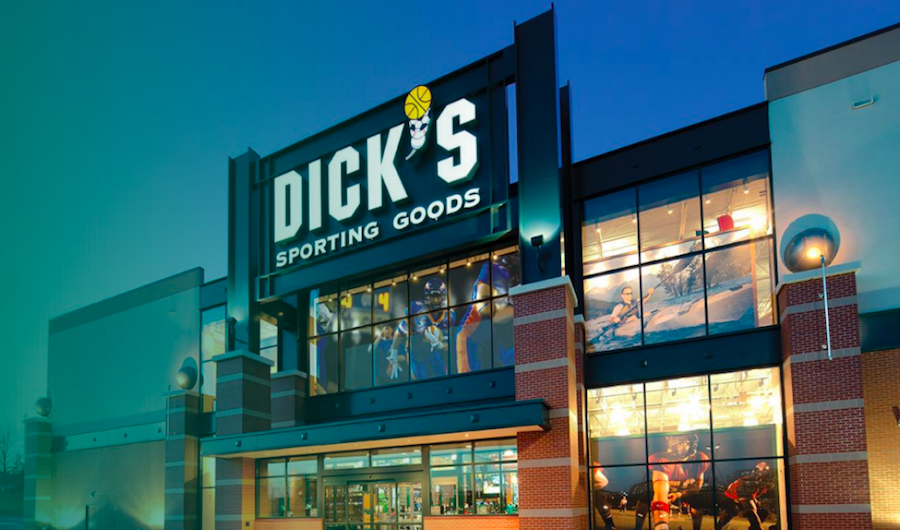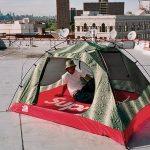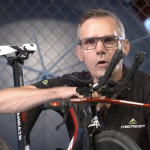Dick’s Sporting Goods Inc. increased its 2018 earnings guidance for a third consecutive quarter as earnings easily beat Wall Street’s targets, thanks to stringent expense controls. Sales, however, came in lower than Wall Street’s targets due to the continued drag from hunt and activity trackers categories, weakness at Under Armour and flat footwear comps.
Shares of Dick’s closed ahead 93 cents, or 2.6 percent, to $37.26, on Wednesday due to the improved bottom-line trend, which also reflected improving merchandised margins.
In the quarter ended November 3, net earnings rose 18.5 percent to $37.8 million, or 39 cents a share, from adjusted earnings of $31.9 million, or 30 cents, a year ago. Results handily topped Wall Street’s consensus estimate by 13 cents.
Including a non-recurring tax benefit, net earnings in the year-ago quarter came to $36.9 million, or 35 cents.
Most of the questions in the Q&A session of the analyst conference call focused on the challenges facing top-line growth with analysts speculating if comp growth was heading for a rebound in 2019.
While earnings guidance was lifted sharply for the year, same-store sales are still expected to slide 3 to 4 percent, implying that fourth-quarter comps will likely decline 3 to 4 percent.
Sales in the latest quarter decreased 4.5 percent to $1.86 billion. Adjusted for the calendar shift due to the 53rd week in 2017, same store sales decreased 3.9 percent on a 13-week to 13-week comparable basis. On an unshifted calendar, same store sales decreased 6.1 percent, versus Wall Street’s estimate calling for a 4 percent decline.
Third quarter 2017 same-store sales decreased 0.9 percent. Transactions in the latest quarter declined by 5.5 percent, and average ticket increased by 1.6 percent.
“Comp sales were in the range of our expectations for the quarter,” said Ed Stack, chairman and CEO, on a conference call with analysts. “As expected, sales were negatively impacted by the continued weakness in hunt and electronics, which contributed to approximately 255 basis points comp decline. Despite these challenges, we have focused on driving profitable sales and managing our business to deliver higher earnings.”
Dick’s best performing categories included outdoor and athletic apparel, which combined for a mid-single digit comp sales increase, and private brands continued to comp positively with higher penetration, as well.
But those gains were offset by double-digit declines in hunt and electronics as well as weakness in outdoor equipment such as camping.
Lee Belitsky, CFO, noted that hunt was cleary impacted by Dick’s decision in February to stop selling assault-style guns and no longer sell guns and ammunition to people under 21 years old in the wake of a shooting at a Florida high school that killed 17 people. But he also noted that the broader hunt industry “has decelerated and remains weak” as evidenced by declining figures in background check data. He said, “We believe this also contributed to the decline we saw during the quarter.”
The drops in electronics, basically fitness trackers, is because Dick’s is phasing out the category.
Adjusted for the calendar shift, e-commerce sales for the quarter increased 16 percent. E-commerce penetration increased to 12 percent of total sales from 10 percent in the same period a year ago.
Earnings were boosted by an improvement in gross margins by 72 basis points to 28.2 percent. Merchandise margin jumped 213 basis points due the declining portion of low-margin hunt and electronic categories, fewer promotions, and an improved product cycle. Those offset occupancy deleverage and higher freight and shipping and fulfillment costs. Additionally, a favorable timing shift related to the expense recognition of changes made to its ScoreCard loyalty program benefited gross profit by $7 million during the quarter.
SG&A expense declined 1.5 percent and was lowered as a percent of sales by 76 basis points to 25.4 percent. Expense reductions more than offset strategic investments and higher incentive compensation.
Inventory levels increased by 0.8 percent in the quarter, or down 1.2 percent on a shifted basis as our quarter ended one week closer to Thanksgiving than last year.
In her comments, Lauren Hobart, president, highlighted Dick’s progress made around three initiatives:
- Improving core execution,
- Leveraging the power of its “expert opinion” to deliver a stronger merchandise assortment and presentation,
- Increasing productivity.
On improving execution, the retailer is focusing on reducing time spent on tasks by store associates so they can focus on helping customers. Online, functionality has been enhanced and estimated delivery times shortened. The goal is to deliver the majority of online orders within two business days and investment are being made in fulfillment and delivery capabilities, including the creation of dedicated e-commerce fulfillment centers in New York and California. All store-focused regional distribution centers were recently enabled to fulfill online customer orders. Shipping from stores is also being leveraged.
On improving in-store presentation, Dick’s is seeing a good response to its “strikepoint presentations,” which showcase key items in impactful ways such as a Yeti display that’s been added to many stores for holiday. Said Hobart, “Year-to-date, many of these strikepoints have resulted in strong double-digit sales growth.”
In marketing, Dick’s is focusing on building an “emotional connection” to drive traffic to stores and online. The holiday campaign focuses on a family bonding around a new ping pong table. Other marketing efforts are focused on using ScoreCard and Team Sports HQ data for targeted messaging as well as joint marketing efforts with vendor partners.
On increasing productivity, Hobart noted that across the company, Dick’s will eliminate approximately $25 million of expenses by year end, much of which has been reinvested in strategic growth drivers. Hobart added, “We will continue to make critical investments to support the long-term growth of our business, particularly in key growth areas such as e-commerce, Team Sports HQ, and our private brands. Improving productivity to help offset some of these investments will be a major priority going forward.”
Addressing potential revenue drivers, Stack noted that Dick’s will be placing a stronger emphasis on key items “and a renewed focused on the enthusiast athlete.”
Said Stack, “We remain encouraged by the improved product we’re seeing from many of our partners and are optimistic about the pipeline into next year. Our relationships with many of these partners have never been stronger, and we will continue to work together to elevate the assortment and presentation at Dick’s.”
He also noted that private brands continue to grow and remain a focus to support differentiation.
“We have seen great success in expanding our existing brands into new categories, and that will be a priority going forward,” said Stack. Dick’s will also be launching new brands. Earlier this quarter, the outdoor apparel brand Alpine Design was launched and Stack said the retailer is “very pleased with the early success.”
Finally, Stack said Dick’s will reallocate floor space to growth categories in key brands and adapt product offering to better align with categories in demand. Late in the third quarter, Dick’s removed virtually all hunt products from 10 Dick’s stores where the category underperformed and have replaced it with “more compelling assortments” in categories such as baseball, licensed products and outerwear.
Added Stack, “Though it’s too early to discuss performance, we’re optimistic these changes will better serve the athletes in these communities.”
For the full year,
- The company lifted its guidance for EPS to a range of $3.15 to $3.25 from $3.02 to $3.20 previously. The company earned $3.01 last year.
- Consolidated same store sales are still expected to decline 3 percent to 4 percent on a 52-week to 52-week comparative basis, compared to a decline of 0.3 percent in 2017.
- Net capital expenditures are expected to be approximately $165 million, down from $225 million expected previously due to the timing of investments. In 2017, net capital expenditures were $373 million.
Said Belitsky, “As we reflect on the Thanksgiving shopping weekend, we are very pleased with our results both online and in our stores, and we have incorporated the results of the weekend in our guidance.”
Many questions in the Q&A session focused on near-term trends as the updated outlook assumes Q4 earnings will arrive in the range of 98 cents to $1.08, below consensus of $1.10 and down from $1.22 a year ago. Comps are expected to decline in the range of 3.1 to 3.7 percent versus consensus targets of 3.1 percent, according to a note from Cowen.
Belitsky noted that Black Friday weekend benefited from “very favorable weather” supporting weather-sensitive businesses. He added, “I’m not sure if that’s going to hold up all the way through Christmas right now. So, we’re pleased with the results, but there’s a long way to go.”
He also implied that the company was anniversarying many of challenges to top-line growth for at least one more quarter. Belitsky noted that hunt is a bigger category in the third and fourth quarter than the first and second and as a result the weakness there is having a bigger impact bigger impact on the overall business. In a similar manner, activity trackers is a bigger business in the gift-giving fourth quarter.
Belitsky also noted that the weakness in some outdoor equipment categories was partly due to weather but it’s also because some firearms customers also bought camp-type categories.
Dick’s has also been reducing its mix of Under Armour product, contending the business weakened when the brand started selling to Kohl’s and some other non-sports-focused chains. Stack said results “were still pretty soft in Under Armour” but he also indicated that Dick’s is pleased with Under Armour’s efforts to offer more differentiation for Dick’s.
Said Stack, “I think we’re seeing better going forward as it relates to us. We’ve worked with Under Armour. We think things with Under Armour in our stores are getting better. We’re enthusiastic about some of the plans we’ve got with Under Armour going forward, and we think the vast majority of this headwind will be behind us as we come out of the first quarter of next year. So, we’re enthusiastic about some meaningful parts of the Under Armour business.”
On other categories, the flat comps in footwear reflect low inventories in the category during back-to-school and improvement is expected going forward. Said Belitsky, “We were a bit under-inventoried there, and we’re fixing that going forward into this quarter and into next quarter.”
Asked about the square footage reallocation, Stack particularly talked up the opportunity in baseball. The CEO said, “We think there’s a big opportunity from a baseball standpoint. That’s a business that’s growing pretty significantly, primarily at the expense of football. As the football business has declined, the baseball business and soccer have picked that up. All of these businesses are a significantly higher margin business than the hunt business.”
He also talked bullishly about signs of an improved product lifecycle across a number of categories.
Said Stack, “Nike has some great product coming out. We’re extremely pleased with Nike on both the footwear side and the apparel side. We’re pleased on the hardline side around golf with what we see with Callaway and TaylorMade going forward. We’re happy with what’s going on with some baseball product we see. We’re just in a pretty good product life cycle. Yeti is still doing very well for us. They’ve got some new innovation out there. Hydro Flask is doing very well. So, we’re just pleased with the products that we see out there today. And not to mention what we’re doing with our own products, whether it be Calia, what we’re doing in the fitness products. We’re going to be launching a new brand next fall, which we haven’t really announced exactly what it’s going to be, but we think it’s going to be one of the biggest private brands we have. So, we’re pretty enthusiastic about the product cycle out there, both from the brands and what we’re doing internally.”
Belitsky also stressed that despite the conservative outlook on the fourth quarter, Dick’s is optimistic about driving positive comps in 2019. The CFO said, “Again, our view for next year really hasn’t changed on that. Our apparel business has been gathering momentum. Footwear business is decent right now. As we anniversary the hunt business, the changes we made there, the electronics business and some more of the Under Armour pieces from the early part of last year, our view hasn’t changed. We think that the vast majority of these headwinds will diminish and we’ll be in a better position to drive more favorable comps.”
Asked about the competitive landscape, Stack added that despite the exit of several competitors, including Sports Authority, he sees “better competition,” pointing to Amazon as “clearly our number one competitor.” He also cited “Academy and a few people like that” as healthy competitors said indicated that its branded partners “are more competitive” with their own direct-to-consumer efforts while also sharing information to support Dick’s growth.
Summed up Stack, “So, the competition has gotten maybe less competitors, but the competition is better than it was in the past.”
But Stack still sees Dick’s gaining market share in the reshuffled retail environment. He said, “We actually think that we’re picking up market share in a lot of the categories. We think we’re picking up market share in golf in the team sports category. There’s a number of ones we think we’re picking up market share. We’re pretty enthusiastic going forward.”
Image courtesy Dick’s Sporting Goods
















